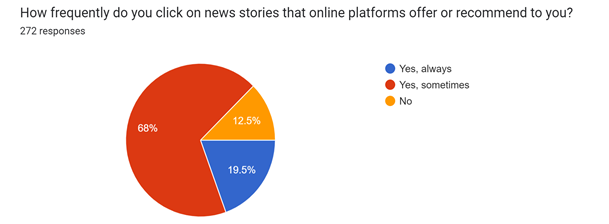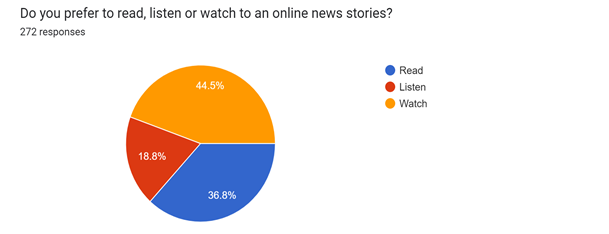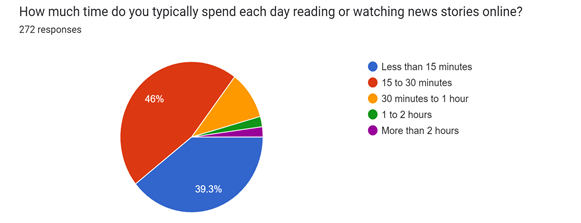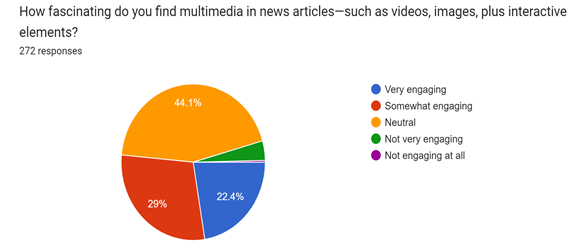ShodhKosh: Journal of Visual and Performing ArtsISSN (Online): 2582-7472
|
|
INVESTIGATING PATTERNS OF DIGITAL NEWS CONSUMPTION AMONG COLLEGE STUDENTS
Rajeshwari N 1 ![]()
![]() ,
Dr. Lourdu Vesna J 2
,
Dr. Lourdu Vesna J 2![]()
![]()
1 Assistant
Professor of Mass Communication, Department Loyola Academy & Research
Scholar, Mother Teresa Women’s University, India
2 Assistant
Professor of Visual Communication, Department Mother Teresa Women’s University,
India
|
|
ABSTRACT |
||
|
Technological
advancements have altered news consumption among everyone. This study scrutinises online news habits, exploring digital
preferences and influencing factors, especially among college students aged
18-21 years. The research employed a mixed-methods approach, incorporating
quantitative surveys (including 272 students) with qualitative insights
obtained from agreed-upon students for interviews as a source of primary data
gathering. Illuminating the unexplored dimension of college students’ digital
news consumption, the study provides insightful perspectives for fostering
informed societies. College students predominantly opt for occasional news
consumption via social media, particularly Instagram. |
|||
|
Received 10 October 2023 Accepted 07 April 2024 Published 13 April 2024 Corresponding Author Rajeshwari
N, rajeshwari.n26@gmail.com
DOI 10.29121/shodhkosh.v5.i1
NCJCFPC.2024.752 Funding: This research
received no specific grant from any funding agency in the public, commercial,
or not-for-profit sectors. Copyright: © 2024 The
Author(s). This work is licensed under a Creative Commons
Attribution 4.0 International License. With the
license CC-BY, authors retain the copyright, allowing anyone to download,
reuse, re-print, modify, distribute, and/or copy their contribution. The work
must be properly attributed to its author.
|
|||
|
Keywords: Digital News Consumption, Online Journalism
Platforms, College Students, Media Habits, Social Media, Multimedia Content,
Peer Influence, News Trends |
|||
1. INTRODUCTION
From the ancient to the modern eras, there has been a
shift in how people consume media. Contrary to the standards adopted by college
students aged 18- 21 years, our ancestors primarily got their news from
conventional media. The variation is due to differences in Internet usage among
individuals. According to Kepios analysis, the number
of internet users in India rose by 34 million (+5.4%) between 2021 and 2022.
Significant paradigm shifts in society as a result of
technological advancement in the 21st century have an impact on both social
dynamics and cognitive frameworks.
As per
The PR Daily Survey, 2022 The rise
of digital platforms and mobile devices has brought about the age of instant
information, delivered through online channels and networks. Project
Information Literacy survey 2018, found that 93% of respondents who are
students obtained news from discussions with their peers and the classroom
plays a vital role, as an important news source.
According to Reuters' Digital News Report 2023, there has been a change in how Indian internet users are consuming news, with more of them using search engines and mobile news aggregators as their primary news sources. The study demonstrates that most Indians prefer to watch or listen to online news.
College students no longer have to rely just on static information instead news consumption is now dynamic and participatory. A lot of news organisations have their websites and mobile apps with multimedia content such as text, photographs, video and interactive components to increase the rate of engagement with the news content. It also explores the idea of multimedia storytelling and how to make more interesting stories. The landscape of news consumption is changing dynamically, especially from the perspective of college students. They only consume the news items which are quick and easy to scan.
This study fills an extensive academic gap in the literature by emphasizing the specific news-consuming behaviours of college students in the setting of digital platforms.
2. OBJECTIVES
1) Our research aims to identify the preferred news sources and platforms used by college students for consuming news online.
2) We also investigate the factors influencing their news consumption habits such as trust, convenience, peer pressure and social media influence.
3. THEORETICAL FRAMEWORK
Uses and gratification and two-step flow theory are the theoretical frameworks that will be appropriate for the investigation. Uses and gratifications are about the user's freedom of choice over what and how they wish to consume media because according to this theory, viewers are active rather than passive. Since the study discusses the influence of peer groups that serve as opinion leaders, the two-step flow theory is applicable.
4. REVIEW OF THE LITERATURE
Reflecting the changing habits and viewpoints of college students aged 18-21 years, we are indeed witnessing a massive change in the way news is supposedly consumed. Herein lies the immense significance of understanding the complex manner by which our college students interact with news, especially in the era of digital technologies. The research conducted in this paper exposed the pattern in the consumption of news, more specifically among college students, all the while uncovering the shifting role of social media and its impactful perturbation on their daily news experience.
Boczkowski et al. (2017) conducted a study to identify the various social media channels for the consumption of news material. The empirical research approach of snowball sampling and conducted a series of sixteen open-ended interviews focused on the region of Argentina, young user demographic. The majority of today's youth connect with media outlets mostly through the ease of their mobile devices. One of the study's clear conclusions was that the news that young people obtain on social media platforms can be categorised as "incidental news."
Winter (2018) study on the effects of social networking sites (SNS) on news consumption explores how sites like Facebook affect readers' perceptions. It investigates the hypothesis that the prevalence of self-presentation and interpersonal relationships on SNS causes an impression-driven form of reasoning by drawing on the heuristic-systematic model. The study controls two crucial variables: the media context (SNS vs. SNS with the expectation of future interaction vs. online news site) and the valence of user comments (positive vs. negative). It involves 210 participants in a pre-registered laboratory experiment. The results show that this impact extends to online news sites and is unaffected by self-monitoring inclinations, contrary to the hypothesis that user comments would be more influential on Facebook. This demonstrates the significance of online commentary in influencing public opinion, regardless of the venue and has implications for raising informed citizens.
Pryahina (2019) examine how Internet
memes function as essential elements of the visual presentation of news
messages within the framework of social media communication patterns in their
study. The authors define visual memes as language units made up of images,
photos, or phrases, understandable to particular social groups, using data from
publications between 2018 and 2019 on seven news pages within the well-known
Russian social network VK, chosen for their post structures and varied
political viewpoints. The authors claim that memes give news pages a method to
express their opinions, attitudes and stances
alongside factual news items concisely and straightforwardly, giving messages
an emotional edge and moving them away from impartiality. This emotional
component creates recognisable cues for subscribers that help them navigate the
vast amount of information and opinions present in social media, adding to the
platform's varied communication landscape.
In the
"News Finds Me" study, Segado Boj
et al. (2019) examined whether consumers used
social media and personal connections rather than conventional media to stay
informed. An online self-administered questionnaire was used to collect the
data from a sample of undergraduate students from the universities in the
Madrid region who were chosen at random. This examines the notion that news is
exposed to its consumers rather than vice versa.
Espinar-Ruiz et al. (2020) investigated the news consumption of University of Alicante students in connection to their perception of media and news content throughout a seven-year trial. According to the study, most students prefer to get their news via social media. The least reliable information source is social media, despite being the most popular. A survey was used to acquire the information.
Oppili & Padmanabhan (2023) To understand the pattern of news consumption, 158 undergraduate students between the ages of 17 and 22 participated in the study. The respondents identified as moderate news consumers. Most of the respondents receive news on Instagram and YouTube. Television has a low trustworthiness rating, while print media enjoys a higher one.
The majority of research that has been conducted has mostly centred on digital media and how people use it. However, studies are scarce on changing news consumption behaviours among college students. As a result, more research is needed to investigate college students' news habits and uncover the numerous aspects impacting their digital news trends.
5. METHODOLOGY
This research offers a mixed method of the factors that influence college students' news consumption patterns. The primary data is collected from the voluntary participation of 272 college students who study in an undergraduate college. Male participants comprise 43% (n=117), while female participants comprise 56.3% (n=153). The remaining individuals chose to remain unidentified.
A
survey was distributed to the 272 participants to gather their feedback,
particularly regarding their news consumption habits. The survey examined
students' behaviour when using platforms and tools for online journalism, their
general social media usage patterns and whether they experienced peer pressure
to read a particular news story to understand questions like How significant is
this informational ocean in their lives. How do they navigate all of the news sources?
Out of
272 individuals, 20 were chosen by a convenience sampling technique. These
individuals took part in in-depth discussions in groups to learn more about
their media consumption patterns. The participants were instructed to keep
track of their media usage for a whole week to facilitate this. The study was conducted concerning the Uses
and Gratifications theory. Participants were then divided into groups of four
for conversations in which they examined similarities and differences in their
media-consuming habits. The discussions showed that YouTube ranked as the
second most popular channel for getting news and information, with Instagram
emerging as the most preferred medium, particularly for entertainment purposes.
The conversations made it clear that students predominantly utilise social
media sites, particularly Instagram and YouTube, for both educational purposes
on different topics and for entertainment. In addition to Instagram and
YouTube, some students use other interesting apps like Kahoot for interactive
quizzes, X (formerly known as Twitter) and Inshorts
for knowledge acquisition.
6. FINDINGS
Figure 1

|
Figure 1 Frequency of Reading News, n= 272 |
35.7%(n=97) read news a few times a week, 31.3%(n=85) read rarely, 20.6%(n=56)
read news once a day, 9.2%(n=25) read news multiple times a day, the rest of
them never read news.
Figure 2

|
Figure 2 Obtain News Online n= 272% |
Around 72.8% of students (n=98) use social media pages to get their online news, followed by news apps at 13.6% (n=37), news organisations' websites at 8.8% (n=24) and news websites overall at 8.8%. The remaining methods of getting news include podcasts, way2newsand memes. News Hunt, Way2news, Twitter, inshorts, X (formerly known as Twitter), Wion news, Instagram and YouTube are the most popular platforms or applications that students have utilised to obtain information.
Figure 3

|
Figure 3 Social Media Platform to Access News n= 272 |
Among all the other platforms, Instagram dominates, with 62.9% (n=171) of students using it frequently to access news. With 22.4% (n=61) of them using it, YouTube comes in second, followed by X (formerly known as Twitter), with 5.5% (n=15) of them using it. Other choices mentioned by the students include Reddit, Way2Newsand the Google search engine.
Figure 4

|
Figure 4 Kind of News to Read Online n= 272 |
According to the survey, text-based articles rank first,
with 50.7% (n=138) of respondents saying they like to read them. Social media
memes also assist users in obtaining news updates, guiding them to stay
informed and reading news stories that interest them. The next option is news
that is communicated through video, such as YouTube videos, which attracts
42.3% (n=115) of students. The remaining news content, which consists primarily
of infographics, podcasts, and interactive aspects, is what students prefer to
read online.
Figure 5

|
Figure 5 Impact of Social Media Memes on News Consumption, n= 272 |
Memes on social media are rapidly gaining popularity among college students. It's increasingly important as a form of entertainment today. Social media memes persuaded 59.6% (n=162) of the students, who said they did, read the news. The remaining 40.4% (n=110) respond unfavourably and claim that social media memes normally do not affect them. Funny memes, political memes, film-based memes, sarcastic memes, and troll memes are some of the subcategories of memes that influence people to read news.
Figure 6

|
Figure 6 Determine the Online News Source Reliability n= 272 |
42.6% (n=116) of respondents say they trust any news based on the reputation of news organisations, while 61.4% (n=167) say they trust news information based on verified sources. Students rely on social media posts' number of likes and shares for the validity of any news because of its larger influence. Others rely on suggestions from their peers, double-checking information with additional sources and examining online comments.
Figure 7

|
Figure 7 Frequency of Click on Recommended News Stories n= 272 |
68% (n=185) of them click on the news story that an online platform recommends to them. 19.5%(n=53) claim to read the online-recommended news every day. The others respond that they don't read it at all.
Figure 8

|
Figure 8 Preference of Watching, Reading, or Listening to News Online n= 272 |
44.5%(n=121) of them primarily favour watching news
reports. 36.8% (n=100) of people prefer reading news items, while the remaining
18.8%(n=51) prefer listening to it.
Figure 9

|
Figure 9 Time Spent on Watching, Reading, or Listening to News Online n= 272 |
Students hardly ever read, view, or listen to news items online for more than 15 to 30 times. And many more people read news online in just 15 minutes
Figure 10

|
Figure 10 Effect of Multimedia Content in News Article n= 272 |
Students' opinions on the impact of multimedia information range from neutral 44.1% (n=120) to not at all engaging 29% (n=79) to occasionally engaging 22.4% (n=61) to extremely engaging 4% (n=11) to not at all engaging 0.4% (n=1).
The adoption of technology in journalism has brought about a revolution in news accessibility by a single click. The digital transformation not only makes news readily available but also ensures real-time updates through news websites, social media, and mobile apps. The main issues that students are having are with fake news and information, reliability, and privacy issues with the digital platform.
7. KEY FINDINGS
1)
Frequency
of News Consumption
· Students occasionally read the news, but they don't usually interact with it every day.
2)
Primary
Information Sources
· Social media platforms are the primary news source for these students in their daily lives.
· Online news is obtained through social media pages and news organizations' websites.
· Social media is considered as a medium of information and entertainment for the students.
3)
Preferred
News Platforms
· The most preferred news platforms among students are News Hunt, Way2News, Inshorts and Hindustan Times.
4)
Dominance
of Instagram
· Instagram is the most frequently used social media platform to access news among students followed by YouTube.
5)
Types
of News Content
· Students prefer various types of online news content, including text-based, video-based, infographics and social media memes.
· Social media memes, especially those connecting the film industry with current affairs or political issues, have a significant impact on their news consumption.
6)
Factors
Influencing News Consumption
· Students' news consumption choices are influenced by social media with memes being persuasive.
· Credibility is determined by verified sources and the reputation of the news organization.
· Peer groups play a significant role in students' news consumption.
7)
Sharing
and Recommendations
· Students occasionally share news stories with friends and peer groups.
· They sometimes click on news stories recommended by online platforms.
· Video content is preferred over reading or listening to news stories.
8)
Time
Spent on News Consumption
· Students spend between 15 to 30 minutes going through news stories.
· There is no peer pressure related to news consumption.
9)
Engagement
with Multimedia Content
· Multimedia content fascinates students and enhances their engagement with news.
10) Role
of Technology Adoption
· The adoption of technology makes it easier for students to stay updated with news.
· Scanning news is convenient and has made their lives easier.
11) Primary
Concerns
·
Students' primary concerns when consuming news
include the spread of fake news, privacy concerns and the trustworthiness of
sources.
8. CONCLUSION
In conclusion, this study provides an
examination of how college students' news consumption has changed in the era.
It highlights the impact of digital technologies on how news is accessed
consumed and shared. Notably, it emphasises the crucial roles that platforms
such as Instagram and YouTube play in this transformation. The findings
emphasize more on the essential elements for news organizations such as
diversifying their content and embracing interactive and visual storytelling
strategies to engage with the college student effectively.
The research highlights that 15-30
minutes are only dedicated by college students to online news, emphasizing the
need for concise news articles that efficiently convey important information
within a short period.
However, the major challenges such as
fake news and privacy issues demand urgent attention. Addressing these concerns
is crucial to prevent misinformation and maintain public confidence in the
media. The study underscores the collaborative efforts required from news organisations,
educational institutions and technological platforms
to shape the future of news consumption. News organizations must accentuate
trust and content diversification, educational institutions should focus on
media literacy programs. The research also identifies influential
factors shaping college students' digital news consumption, including social
media memes, the credibility of news organizations and peer groups functioning
as opinion leaders, aligning with the two-step flow theory.
9. FUTURE RESEARCH
In the future, more studies might focus on the impact of memes on news consumption, the efficacy of privacy protections in online news platforms and the changing ways college students consume news. These studies will be crucial resources for adapting to the constantly shifting news consumption environment and collaborating to create a more knowledgeable and engaged citizen.
CONFLICT OF INTERESTS
None.
ACKNOWLEDGMENTS
None.
REFERENCES
Boczkowski, P., Mitchelstein, E., & Matassi, M. (2017). Incidental News : How Young People Consume News on Social Media. Scholar Space. https://doi.org/10.24251/HICSS.2017.217
Espinar-Ruiz, E., Gonzalez-Diaz, C., & Martinez-Gras, R. (2020). Analysis of News Consumption of Students from the University of Alicante. Convergencia, 27. https://doi.org/10.29101/crcs.v27i0.13286
Oppili, S., & Padmanabhan, V. (2023). A Study of News Consumption Patterns Among College Students. ShodhKosh: Journal of Visual and Performing Arts, 4(1SE), 220-231. https://doi.org/10.29121/shodhkosh.v4.i1SE.2023.420
Pryahina, A. V. (2019). The Memes Function in the Visual Design of News Messages. European Proceedings of Social and Behavioural Sciences. https://doi.org/10.15405/epsbs.2019.08.02.50
Reuters Institute. (2021). Digital News Report 2021: India.
Segado Boj, F., Díaz-Campo, J., & Redondo, R. Q. (2019). Influence of the 'News Finds Me' Perception on News Sharing and News Consumption on Social Media.
Winter, S. (2018). Impression-Motivated News Consumption. Journal of Media Psychology, 31(4). https://doi.org/10.1027/1864-1105/a000245
|
|
 This work is licensed under a: Creative Commons Attribution 4.0 International License
This work is licensed under a: Creative Commons Attribution 4.0 International License
© ShodhKosh 2024. All Rights Reserved.

